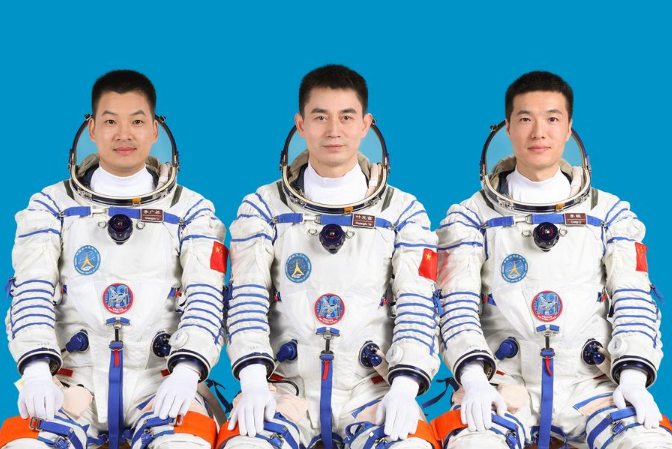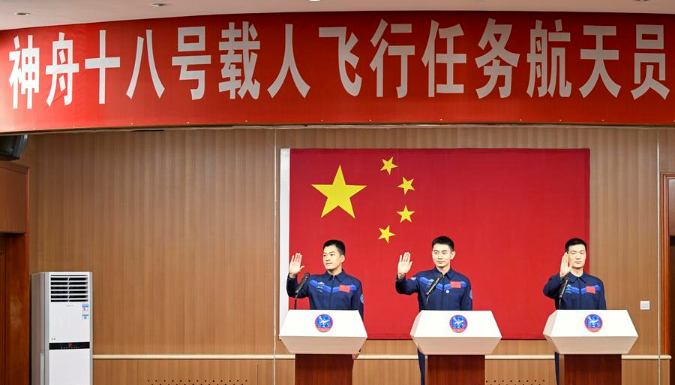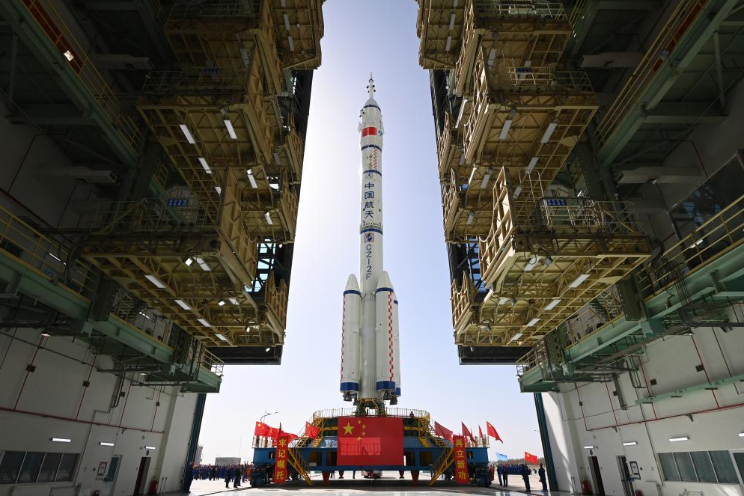China unveils Shenzhou-18 crew for space station mission
* All the three Shenzhou-18 astronauts are from the post-1980s generation. At the press conference, they said they would take good care of the Tiangong space station and make more achievements in the space laboratory.
* The astronauts have made comprehensive, systematic and in-depth preparations for this mission, focusing on extravehicular activities (EVAs), emergency response, space station management, equipment maintenance and experimental operation.
* The crew will stay in orbit for about six months, and they will witness the arrival of the Tianzhou-8 cargo craft and Shenzhou-19 crewed spaceship during their stay.
JIUQUAN, April 24 (Xinhua) -- Chinese astronauts Ye Guangfu, Li Cong and Li Guangsu will carry out the Shenzhou-18 crewed spaceflight mission, and Ye will be the commander, the China Manned Space Agency (CMSA) announced at a press conference on Wednesday.
The Shenzhou-18 crewed spaceship will be launched at 8:59 p.m. Thursday (Beijing Time) from the Jiuquan Satellite Launch Center in northwest China, said Lin Xiqiang, deputy director of the CMSA.
After entering orbit, the Shenzhou-18 spaceship will perform a fast automated rendezvous and docking with the radial port of the space station core module Tianhe, which will take about 6.5 hours, forming a combination of three modules and three spacecraft, Lin said.

This undated photo shows Chinese astronauts Ye Guangfu (C), Li Cong (R) and Li Guangsu who will carry out the Shenzhou-18 spaceflight mission. (Xinhua)
This will be the second space flight mission for Ye Guangfu who was a crew member of the Shenzhou-13 mission from October 2021 to April 2022. Li Cong and Li Guangsu, among the third batch of Chinese astronauts, are both newcomers to space.
"My two crew members and I, as well as the entire space mission team, are fully prepared and confident to complete this space flight mission," Ye told journalists on Wednesday ahead of the launch.
All the three Shenzhou-18 astronauts are from the post-1980s generation. At the press conference, they said they would take good care of the Tiangong space station and make more achievements in the space laboratory.

Ye Guangfu (C), Li Cong (R) and Li Guangsu, the three Chinese astronauts for the upcoming Shenzhou-18 spaceflight mission, meet the press at the Jiuquan Satellite Launch Center in northwest China, April 24, 2024. (Xinhua/Bei He)
UNIVERSAL EXPECTATIONS
Ye, a 43-year-old space returnee, will lead his team in conducting a series of challenging tasks in microgravity.
"Returning to space also feels like a fresh start," Ye said. In comparison to his previous mission, the current space station features a more complex structure, demanding tasks and greater operational challenges. But Ye said the new crew is brimming with confidence.
During the Shenzhou-13 mission, the ground team assisted Ye in exchanging friendly greetings with a foreign counterpart through email.
"We two astronauts, one on the Chinese space station and the other on the International Space Station, shared our dreams of exploring the vast universe together," Ye recalled.
The first Chinese astronaut to participate in multinational training, Ye has also extended invitations to international counterparts to visit China's space station. "We extend our warmest invitation to international colleagues to join us in exploring its vast potential and working towards benefiting all humankind," he said.
"We have made comprehensive, systematic and in-depth preparations for this mission, focusing on extravehicular activities (EVAs), emergency response, space station management, equipment maintenance and experimental operation," Li Cong, the youngest member of the Shenzhou-18 crew, told the media on Wednesday.
During the Shenzhou-18 mission, the main jobs of crew member Li Guangsu will be space experiments and tests in the cutting-edge fields such as aerospace medicine, basic physics, material science and life science.
"I am looking forward to the speed and passion of 7.9 kilometers per second, the special experience of weightlessness, and the wonderful feeling of flying without wings," said Li Guangsu.

This photo taken on April 17, 2024 shows the combination of the Shenzhou-18 crewed spaceship and a Long March-2F carrier rocket being transferred to the launching area of the Jiuquan Satellite Launch Center in northwest China. (Photo by Wang Jiangbo/Xinhua)
TASKS AHEAD
The crew will stay in orbit for about six months, and they will witness the arrival of the Tianzhou-8 cargo craft and Shenzhou-19 crewed spaceship during their stay, Lin said.
The crew will utilize the scientific experiment cabinets and extravehicular payloads to carry out more than 90 experiments in the fields of basic physics in microgravity, space material science, space life science, space medicine and space technology, Lin said.
The country's first in-orbit aquatic ecological research project will also be implemented during the mission. Using zebrafish and goldfish algae to establish a self-cycling aquatic ecosystem in orbit, the project aims to make to a breakthrough in the cultivation of vertebrates in space, Lin noted.
The world's first in-orbit stem cell study on the plant's stem tips will be made to explore plant evolutionary adaptation to gravity and provide theoretical support for space cropping, said Lin.
The Shenzhou-18 astronauts will carry out two to three EVAs, implement six cargo outbound deliveries via the station's cargo airlock module.
During the EVAs, the astronauts will install space debris protection reinforcements for extravehicular piping, cables and critical equipment, and carry out extravehicular inspections, as appropriate, to further ensure the safety of the space station, Lin said.
The Shenzhou-18 crew are scheduled to return to the Dongfeng landing site in north China's Inner Mongolia Autonomous Region in late October this year.
(Editor: wangsu )


